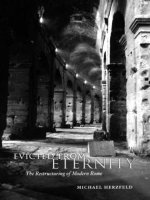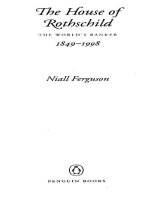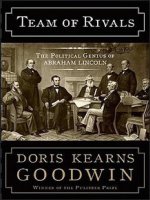Stewart onan the circus fire (v5 0)
Bạn đang xem bản rút gọn của tài liệu. Xem và tải ngay bản đầy đủ của tài liệu tại đây (5.81 MB, 285 trang )
Acclaim fo r Ste wart O'Nan's
The Circus Fire
“The Circus Fire is terrifying, compelling, and absolutely read able—because it is real. It happened in 1944,
but Stewart O'Nan brings it to life again, along with its heroes and villains, and makes you feel like you're
inside the big top as it starts to burn.”
—Rick Bragg
“A tting and poignant memorial to the victims…. To his credit, O'Nan sticks with the facts and by doing so
enables the story to tell itself.”
—Chicago Tribune
“Taut and loving, this book strains to the heart's outer limits. The Circus Fire is journalism in the service of
literature, literature in the service of history.”
—Rick Bass
“Mr. O'Nan's research has been prodigious, and his presentation of his findings is expert.”
—The Atlantic Monthly
“Like Jon Krakauer's Into Thin Air, The Circus Fire does more than just re-create and explain disaster. It
examines its human cost.”
—Minneapolis Star Tribune
“A superbly written and absorbing book, admirably documented. This is a candid picture of humans at their
best and their worst, and deserves a place on the shelves of any serious student of the American circus.”
—Jim Foster, editor, The White Tops, official publication of the Circus Fans Association of America
“O'Nan endows The Circus Fire with a haunting literary sense of time and place, enhancing the non ction
genre within which he works.”
—Austin American-Statesman
“The real gut punch of the book is delivered by some very per sonal stories…. For all the sadness, however,
this book is a sat isfying read that sidesteps sensationalism. It includes stories of unsung heroes, those who
reacted to disaster with strength and courage, and those who used the situation as a starting point for
change.”
—The Denver Post
“A remarkable piece of reporting…. [O'Nan] shows an earnest dedication to giving the story what it deserves:
a solemn, care ful telling.”
—The Hartford Courant
“[O'Nan's] thoroughness takes in a myriad of often con icting perspectives until he creates a mosaic that
includes the pica yune and the epic… [an] unflinching account… tense and grisly.”
—San Francisco Chronicle
“It seems strange that one of the most devastating tragedies in American history had, until recently, not
received in-depth coverage outside of newspapers. Stewart O'Nan's excellent book has provided that
coverage in a de nitive yet easy-to-read style…. It is as fast-moving as a novel, yet it left very few ques tions
unanswered.”
—The Little Circus Wagon
“One of the best examples of nonfiction narrative writing I've ever encountered…. The Circus Fire sets the bar
many notches higher for all who would aspire to write such ‘nonfiction novels.’”
—David Dawson, The Commercial Appeal
“Spectacular…. The e ect of this book is like that of Sebastian Junger's The Perfect Storm…. In focusing on
what psychologists say are predictable human responses to sudden danger, O'Nan makes us all wonder what
would have happened to us if we'd been at the circus that day.”
—The Arizona Republic
“A compelling story…. Those who read it won't soon for get it.”
—The Dallas Morning News
The Circus Fire
Stewart O'Nan is the author of ve critically acclaimed novels—Snow Angels, The Names of the Dead, The Speed
Queen, A World Away, and A Prayer for the Dying—and served as the editor for The Vietnam Reader. He lives in
Avon, Connecticut.
Also by Stewart O'Nan
A Prayer for the Dying
A World Away
The Speed Queen
The Names of the Dead
Snow Angels
In the Walled City
Editor
The Vietnam Reader
On Writers and Writing, by John Gardner
This book is for everyone who went to the circus that day—
those who came home
and those who stayed.
Contents
Foreword
CLEVELAND, 1942
JULY 4, 1944
Principals
JULY 5, 1944
JULY 6, 1944
Circus Day
Showtime
The Point of Origin
Our Boys in Uniform
Blue Sky
Animal Acts
The Bravest Girl I've Ever Seen
This Ain't No Time to Faint, Lady
Don't Look Back
The Stars and Stripes Forever
Ten More Bars!
Death by Fire
Alive, Alive, Alive
Have You Seen Him?
Bringing Out the Dead
Triage
Unexpected Guests
Extra, Extra
We Can't Reach You, Hartford
A G.I. Party
The Names of the Dead
Bad Face
Evidence
In the Evening, Sun Is Going Down
Go to Sleep
Bad News
Were You in Cleveland?
All Through the Night
And on Till Morning
JULY 7, 1944
JULY 8, 1944
JULY 9, 1944
JULY 10, 1944
JULY 11-JULY 15, 1944
JULY 15-JULY 31, 1944
AUGUST-DECEMBER, 1944
1946-1950
1950-1990
1990-1991
1991-1999
Acknowledgments
Foreword
I did not want to write this book. Why I attempted it I'm not precisely sure. Certainly not because I had some
personal connection to the circus re or because I had something deep and meaningful to say about it. I suppose
it was because I found the re a strange and tragic event, one that had taken place in the city I had just moved to.
In the beginning, writing about the re was a way, maybe, of learning not only about the mysteries surrounding
the fire but also the history that shaped the place I live.
I rst ran across a mention of the re ten years ago in an old Life magazine while I was doing research for a
novel. The notion of a circus tent burning down and children dying inside it shocked me, as did the pictures
accompanying the article.
I must have led the idea and the images away in my head, as I often do with unsettling things, because years
later when we moved to Hartford, I recalled the re and its e ect on me. I decided I should read more about it, so
I went to the library and asked for a good history of it.
They didn't have one.
Maybe another library around town?
No, what they meant was, there wasn't one.
I thought that was wrong. The circus re was the biggest disaster in the history of the state, and such a strange
one. So many people had died, I couldn't believe no one had commemorated the event, set it in words for later
generations.
I didn't want to write a book about the re, I just wanted to know what happened. I started asking people
around town what they knew about it.
Everyone had a friend or neighbor who had been there that day, a grandmother or a cousin. Everyone had a
story. People of that generation knew exactly where they were that afternoon, just as, later, they could recall what
they were doing when President Kennedy was shot. The fire had that great of an impact on the city.
By then I'd begun to do research, thinking—not realistically—that maybe I could interest someone who knew
how to write non ction in taking on the project. I'd gather the material and hand it o to a professional and in a
year or two I'd have that book I wanted to read.
Soon I had several notebooks full of photocopied documents, and the novel I thought would take me into the
next century was finished. Suddenly I had the time and obviously the interest. I was stuck.
By choosing to write the book, I would assume the obligation of telling hundreds of survivors' stories. I would
become—in a way I did not feel comfortable with—the custodian of the circus re, implicitly charged with not
only telling its story but also, in the method of telling it, in my choices as a writer, interpreting the re, imbuing
it with whatever meaning I felt it had. I did not want that responsibility, but at that point what I wanted no
longer mattered. The fire had me, and I had it.
When I rst told people not from Hartford that I planned to write a non ction history of the re, they asked
me why I didn't just write a novel. The question surprised me; I'd never thought of writing a novel about it. From
the beginning, because of its vague, legendary nature, I felt it deserved only the most stringent, very best
intentions of non ction, the idea being to tell the truth about an event that changed the lives of tens of thousands
of people. I suppose I thought I might cheapen the fire by fictionalizing it.
As I dug deeper into the research, I discovered my choice of non ction was right for a simpler reason: the fact
that truth really is stranger than ction. Not merely weirder, but packed with coincidences, gaps and lapses that
well-made
ction can't tolerate. The subject—the deaths of 167 people, most of them women and children—
seemed to beg for a clear and de nitive telling, yet the picture available to me was fragmentary and often
contradictory.
The story of the circus
re, as Hartford already knows, is not just a tragedy but also a mystery, probably
insoluble, which keeps it alive and vital in the city's imagination, an emotional touchstone. This mix keeps it
fascinating yet frustrating. The answers we want nailed down can't be. Only in ction could the story of the circus
fire be made complete, its missing pieces found and fitted neatly into place. But then it wouldn't be true.
Even this is a best guess. Though I've tried to be careful in my interviews with survivors and the families of the
dead, and diligent in my research of the existing
les, the circus
re is essentially a mystery, now further
obscured by time. This account cannot possibly contain the whole, complete truth of what happened without
including all of the literally thousands of stories of that day and the hard days beyond. That book would be as
wide as life and as long as memory.
This book contains just some of what I learned about Hartford and how it responded so heroically to a terrible
and unique tragedy. As a history, it hopes to x a time and a place long gone, to preserve it so readers can visit it
and try to understand what the people of Hartford went through, how they faced the worst and bravely found
ways to carry on, as people are asked to do every day.
Any errors or critical omissions in this book are mine. To all those who recognize them, I apologize.
A carnival should be all growls, roars like timberlands stacked, bundled, rolled and crashed, great explosions of
lion dust, men ablaze with working anger, pop bottles jangling, horse buckles shivering, engines and elephants in
full stampede through rains of sweat while zebras neighed and trembled like cage trapped in cage.
But this was like old movies, the silent theater haunted with black-and-white ghosts, silvery mouths opening to
let moonlight smoke out, gestures made in silence so hushed you could hear the wind zz the hair on your
cheeks.
More shadows rustled from the train, passing the animal cages where darkness prowled with unlit eyes and the
calliope stood mute save for the faintest idiot tune the breeze piped wandering up the flues.
The ringmaster stood in the middle of the land. The balloon like a vast moldy green cheese stood xed to the sky.
Then—darkness came.
—Ray Bradbury, Something Wicked This Way Comes
Cleveland, 1942
They played by the lake, their tops guyed out on the lot by Municipal Stadium. The
Indians were on the road, and healthy crowds turned out for the big show. Only the
Pennsy tracks ran between them and the shore, fenced them in along the blu s. All day
a breeze off the water snapped the flags of the big top.
It was August and hot. It was the rst summer of the war and already they were short
of men. Their owner John Ringling North had scaled back to a four-pole big top from
the traditional six, but layout superintendent Leonard Aylesworth still had to recruit
neighborhood kids to help his men erect the tents.
They were always late that summer; the engines they relied on to pull their trains
were needed for the war. The O ce of Defense Transportation decided when they went
and how they got there—a problem only made worse by the oversized atcars they used
to haul their wagons. The curves on some routes were too tight and there were delays,
hours spent stalled on sidings to let troop and munitions trains through. The jumps
between cities took too long, and then setting up was slow, and the matinees got pushed
back.
On top of that, the man who usually oversaw all these logistics, general manager
George Washington Smith, was gone, o to the Army's War Show, an open-air mockbattle pageant designed to sell victory bonds by displaying the tanks and planes and
howitzers the country was subsidizing.
Still, Ringling Bros. and Barnum & Bailey Combined Shows made their dates. Blowing
a show was bad luck, and they'd had enough of that already. There was serious money
to be made. War plants were running three shifts and everyone had a fat paycheck, not
like a few years ago. Just two railroad shows had survived the Depression, and the Cole
Brothers only remotely rivaled Big Bertha.
This was still the Greatest Show on Earth, with its tradition and glitter, a new
elephant ballet scored by Stravinsky and choreographed by Balanchine, and stars like
Emmett Kelly and Alfred Court, the Wallendas and the Cristianis and the Flying
Concellos, even menagerie draws like Gargantua the giant gorilla and his bride M'Toto,
who did nothing but loll around in their air-conditioned cages until it was time for their
twice-a-day staged wedding. One hundred clowns, the posters boasted, one thousand
animals.
People came out to see them and forget the war, if only for a moment. There was a
promotion where if you bought a bond you got a free grandstand ticket, and the show
this year was decidedly patriotic, the big spectacle or “spec” a celebration of American
holidays, the nale of the closing spec capped by the unfurling of four huge portraits of
President Roosevelt. Servicemen in uniform were admitted free.
The '42 show had done well so far, opening strong in Madison Square Garden,
following that with a good run at Boston Garden, then dipping down south to Baltimore
to open under canvas. They played packed houses all the way up the eastern seaboard—
Hartford was especially good, with Colt's Firearms and United Aircraft there—before
turning inland across upstate New York. In Syracuse they played a straw matinee, the
over ow crowd sitting on the ground, and then a turnaway that night, the big top so
full even John Carson's opportunistic crew of ushers couldn't shoehorn one more rube in.
Sellouts in Schenectady and Utica, a big house in Bu alo, but then when they hit
Pittsburgh it rained.
It was a rough go. During the opening matinee, one of Alfred Court's lions attacked
trainer Vincent Souday, laying his right thigh open from groin to knee. Court himself
rushed in to nish the act, but the damage was done, the mood had been set. It poured.
For the six-day stand the backyard was mud, the girls in the spec hauling on boots, their
rainy day costumes clammy, never quite dry.
At the employment o ce downtown the circus requested permission to hire 150 more
workers, but war industries had priority, and Pittsburgh, the steel capital of the world,
was working round the clock, the mills churning out clouds so dark the city kept their
streetlights on all day long. The young, unattached men whom the glamour and freedom
of circus life had always drawn were in dire short supply. The show took on anyone who
signed up and was happy to get out of town.
Cleveland was a four-day engagement, August 3rd through the 6th, shows at 2:15 and
8:15 daily, doors open at 1:00 and 7:00, same as always. Like the army the circus
operated by clockwork; every working person knew where they had to be and what they
had to do. In the last war it was said the Kaiser had modeled his army's transportation
scheme after Barnum's. The routine de ned everyone's day; in a way it comforted them,
gave them something solid to hang on to.
Opening day was unremarkable, the performances sharp, the weather mercifully
clear. The lot had a view of the harbor, two stone jetties tipped with white lighthouses
reaching into blue, blue Lake Erie. The tent was air-conditioned, another new-fangled
idea of John Ringling North's. After the withering heat of the grounds and the sti ing
humidity of the menagerie tent with its ripe zebras and camels and elephants, the
matinee customers appreciated it. That night the crowd was larger, swelled by families
and workers finished with day shift.
The morning of Tuesday the 4th, the dew and the cool fog burned o and the day
promised to be sunny. Kids who showed up early enough were hired for the price of a
pass to scrounge around under the bleachers and retrieve last night's empty Coke
bottles. The lot was too small for the cookhouse, so it was across the street from the big
top. As the sta fried pork chops and bacon and eggs and toast for breakfast, cageboys
bumped wheelbarrows piled with chunks of horsemeat between the big cats' wagons.
The tethered camels and zebras tucked into piles of fresh hay. It was all clockwork, and
after Pittsburgh, welcome.
Around 11:30 A.M. the ag on the cookhouse went up for lunch, and the hands left
their charges grazing away. The rst call for the sideshow was noon. The kid show, it
was called, with the Doll Family of Tinytown, Percy Pape the Living Skeleton, and Dr.
May eld the Fire Proof Man, among others. Pretty soon the towners would roll in, the
midway would ll up, and the talkers would have to step out on the bally platform and
turn the tip—convince the crowd to line up at the ticket boxes and fork over cold cash to
see Mo-Lay the comedy juggler and Egan Twist the Rubber-Armed Man and Miss
Patricia the hot-neon-tube swallower. A clutch of spielers and performers were waiting
for their lunch orders when someone ran through the doorway and shouted that the
menagerie was on fire.
They all ran.
What happened happened fast. As they dashed across the street to the midway, they
could see black smoke pouring up and ames racing along the peaks of the menagerie
top. Inside, the elephants were staked to the ground front and back with iron chains.
They were trumpeting.
Two men ducked into the canvas marquee and began tearing the steel railings in front
of the ticket booths out of the ground. The rst came easily. As they tugged at the
second one, a giraffe bounded past them and galloped across the lot.
Hands broke out water buckets and re extinguishers, but the breeze from the lake fed
the ames. Scraps of canvas oated free, rose like balloons on the superheated air.
Luckily the wind was blowing from the northeast and pushed the re away from the
adjacent big top. Only the poleless gorilla top, home of Mr. and Mrs. Gargantua,
separated the two large tents. Their handlers immediately cut the ropes, dropping the
untouched canvas over their cages. A circus water truck arrived with a short section of
hose and wet the canvas down, allowing a tractor to come in and haul the Gargantuas'
wagons off, their air conditioners still humming.
Inside, aming pieces of the tent dropped into the straw and hay. It went up like dry
brush. Cageboys untethered their animals and led them out, then went back for more,
hunched over from the blaze above. Big John Sabo, the menagerie super, made three
trips before the heat drove him out. One zebra was running around wild, turning circles
in the smoke; it shot out of the main entrance and zigzagged over to the grade by the
railroad tracks where a number of hands closed in and wrestled it to the ground. An
ostrich sprinted out, on fire; it took three men to tackle it and beat out the flames.
The elephants still hadn't budged and wouldn't until the boss of the bull men, Walter
McClain, arrived. McClain was a giant of a man with an even greater reputation as a
trainer. He knew his bulls would wait for him, so he led his men in even as the roof
above them was coming apart. The men scampered around to the rear stakes and
unlinked the beasts' shackles. At McClain's command the elephants reached down with
their trunks and yanked their front stakes out of the ground. Another word from him
and they marched out in procession, trunk to tail. Some were horribly burned, their esh
hanging in strips, peeled off like rind, but they were out.
Three they couldn't reach. One, Ringling Rosie, they freed from her chains, but she
was spooked and refused to leave the burning tent. The heat was down on them now,
pushing them out. McClain stayed as long as he could (the right side of his face would be
burned pink from his hairline to his collar), then ran. From outside, witnesses watched
Ringling Rosie stomping back and forth as the flames enveloped her.
These camels never left their bed of straw. Workers stand about helplessly as Cleveland
remen mop up. In the left background, behind the now-empty rigging, rises the four-pole big
top. PHOTO COURTESY OF THE CIRCUS WORLD MUSEUM
Likewise, the camels refused to move, balked at any e ort to save them. They folded
themselves down in their straw and the re broke over them. The canvas was coming
down, pieces burning in the dirt. In their cage wagons, the big cats roasted in their
bedding, unable to escape.
The re was mostly smoke now, the poles and wire rigging of the top charred and
bare, yet still standing. The top was gone, consumed like tissue paper, nothing but
scraps left. It had only been a few minutes.
The circus water trucks and the rst Cleveland engine company to arrive played
streams of water on Ringling Rosie. As police cordons held back the crowds,
workingmen battled the res inside the cages. Steam poured o of the charred wood.
Inside, lions and tigers and pumas squirmed in the cinders, their coats smoking. Some
lay still. The cageboys sobbed.
Firemen quenched what was left of the re—hay and smoldering rope—while John
Sabo and show veterinarian J. Y. Henderson took inventory. Two gira es had been
incinerated in their chain-link partition; how the third had escaped no one could gure
out, but it was safe, just bruised and scratched from falling hard as workers corralled it.
Another unlikely survivor was Betty Lou, the pygmy hippo; she'd saved her own life by
diving into her bathing tank and staying submerged until a tractor driver snaked her
wagon out of danger.
Few others were so lucky. Ringling Rosie stood among the bodies strewn through the
charred mud and puddles of black water, pink bleeding patches where her skin had been
stripped o . Dr. Henderson was hoping to spray her with an unguent called Foille, a
new medication invented for industrial burns. When Walter McClain ordered his men to
double-chain her for the treatment, she went berserk, and afraid she might break loose,
a city detective had to shoot her between the eyes with his.45. The pistol wasn't enough
gun. The shot knocked her down but she was still breathing. Dr. Henderson had to ask a
police ballistics expert to use his submachine gun on her.
One of the three gira es there that day. Only one survived—Edith, who somehow vaulted the
corral. PHOTO COURTESY OF THE CIRCUS WORLD MUSEUM
The elephant line stood in the street, quietly receiving treatment. They were burned
mostly on their heads and trunks, their thin ears crisped. Trainers daubed Foille on their
raw flesh with paintbrushes.
The three other elephants McClain's men couldn't get to were hurting. Later that
afternoon another policeman put down Little Rosy, who was just too badly burned.
The camels were the worst, and the big cats. Police and Coast Guardsmen brought
over high-powered ri es and ammunition from a nearby armory. One camel handler
begged them not to shoot his animals, others cursed them, but it was necessary.
Dr. Henderson went hopefully from cage to cage with his sprayer of Foille. The cats
looked up at him, licking their burned paws, wisps of smoke still rising from their fur.
The doctor asked a detective for his pistol. The Coast Guardsmen were there with their
ri es for the larger animals. Together they had to shoot three camels, three lions, and a
puma. The thing he would never forget, Dr. Henderson said later, was how, throughout,
the animals were completely silent.
•••
The Cleveland menagerie re was a shock, even more so because it was wartime and
the circus was supposed to be a diversion from that larger tragedy, but anyone who
knew the circus knew it had a history of disasters.
From the beginning, American circuses seemed prone to re—perhaps naturally,
considering their early performances were lighted by either candles or oil lamps. In
1799, Rickett's Equestrian Circus, widely recognized as the rst in America, lost their
Philadelphia amphitheater when it burned to the ground.
P. T Barnum seemed especially susceptible. Fire destroyed his American Museum at
Broadway and Ann Street in lower Manhattan in July of 1865. Hoping to douse the
oors below, remen smashed the thick glass of the whale tank; the tactic didn't work,
and the whales burned alive. Barnum quickly rebuilt a few blocks away, but in 1868 re
struck again. In 1887 the Barnum & London winter quarters in Bridgeport, Connecticut,
burned, killing most of the circus' animals. It su ered another major blaze in 1900, and,
though Barnum himself was gone by then, several minor res almost yearly through the
teens, capped by a $100,000 loss in 1924. In '27, the Combined Shows moved their
winter quarters to Sarasota, Florida, ending his strange legacy
The Ringling Bros. had the reputation of being ridiculously lucky, partly because of
their competitors' perception of them as high and mighty, holier than thou. They ran
what was known as a Sunday School show, going so far as to ban swearing on the lot.
With no rigged midway games or salacious girlie acts, they continued to outgross other
less savory out ts, often by promoting their squeaky-clean image. The Ding-a-ling
Brothers, cynics called them, the Five Deacons. The rst re of note that struck them
was in August of 1901 in Kansas City, Missouri; the sideshow tent burned, but, as their
famous luck would have it, no one was hurt.
Barnum & Bailey—before the 1919 merger the sole and original Greatest Show on
Earth—was possibly even luckier. In May of 1910, on a Saturday afternoon in
Schenectady, New York, their big top caught re with fteen thousand souls in
attendance. Fred Bradna, the big show's equestrian director at the time of the Cleveland
menagerie re, was about to blow his whistle for the opening procession when he saw a
patch of flame waving above the bleachers. He asked the spectators to please leave their
seats in an orderly fashion, and they did.
The 1910 Schenectady big top re, as seen from a perch overlooking the midway, the
sideshow top behind a wall of banners. PHOTO COURTESY OF THE CIRCUS WORLD MUSEUM
Schenectady. The cables of the rigging are visible, still attached to the tops of the quarter poles.
PHOTO COURTESY OF THE CIRCUS WORLD MUSEUM
There was no panic. The re looked so insigni cant that they climbed down the
grandstands and bleachers and stood on the track and in the rings, watching as
canvasmen climbed up onto the top and tried to cut out the burning section. A re
station directly across the street laid in hose immediately and focused water on the top,
but soon it became apparent that they could not easily contain the blaze, and the crowd
scurried out the main entrance and the back door and under the sidewalls, all without
injury.
Witnesses at a country club overlooking the lot said they saw great masses of aming
canvas oat up into the sky, the re consuming them as they rose, a magician's trick. In
minutes the poles were on the ground, though some of the canvas escaped untouched
and the stands were saved. No one was hurt. The greatest loss was loss of face; once the
re was out, the crowd besieged the ticket wagons, demanding their money back. The
ticket sellers were saved only when drivers hitched teams to the wagons and dragged
them off.
The Ringlings' luck struck again in August 1912, in Sterling, Illinois. The big top was
set up on a racetrack pasture. At one o'clock ten thousand people were waiting for the
doors to open for the matinee when a barn a few blocks away caught re. Al Ringling
noticed the wind lifting burning shingles into the air and ordered the doors closed. As he
feared, a brand landed on the roof of the top and the flames jumped up. The tent burned
in minutes. By this time, Fred Bradna had moved to the Ringling Bros., so he was a
witness again. Hook men calmly hustled the elephants away, as everyone feared a
stampede. Again no one was hurt. The poles and stands needed only sanding and a new
coat of paint.
The next morning the Sterling Daily Standard reported that the initial cause of the re
was either a spark from an engine or some boys seen smoking cigarettes around the
barn. “The rapid destruction of the big tent has caused much speculation,” the Standard
said, “and people who witnessed it go up in ames today are still wondering what made
the big tent go so quickly. The truth is the tent was covered with para ne to keep out
rain and when the re started this to melting it also added fuel to the ame and caused
the more rapid destruction of the big tent.”
The re itself was a spectacle worthy of a circus. A picture of the burning tent won
first prize in a photography contest held by a national magazine.
No other big top burned in the years between 1912 and the Hartford re of '44, so it's
not odd that the Sterling re and the Hartford disaster are often paired in news stories.
Both were matinees and both tops were the Ringling Bros. But the show had two other
major fires very shortly after Sterling that are less well known.
The rst was in Cleveland, this one also by the lakefront lot. In May 1914, forty-three
railway cars went up while sitting mostly empty on a siding. The second was in October
1916, when the baggage stock tent burned in Huntsville, Alabama. Forty draft horses
were incinerated; forty more had to be killed. According to witnesses, the re took ve
minutes.
Even more than res, train wrecks have plagued circuses over the years. The most
famous wreck deserves mention here. It also occurred during wartime, in June 1918. At
4:00 in the morning, the crew of a train carrying the Hagenbeck-Wallace Circus stopped
near Ivanhoe, Indiana, to x a hotbox. The engineer pulled most of the train onto a
siding, but the last ve cars, including four sleepers, were still sitting on the main line.
Miles away, an empty troop train blew through stop signals, its driver asleep at the
wheel from a dose of kidney pills. In the old wooden sleepers, the circus workers and
performers slept in their cramped berths, kerosene lanterns burning dimly above the
aisles.
The crew of the circus train heard a distant chu ng and turned from their work to see
the headlamp of the troop train bearing down on them. The driver had nally woken
up, but it was too late for the brakes. The engine tore through the sleepers, driving them
together, pitching them in a heap. The injured were trapped in the splintered wreckage,
and as rescuers clambered in to help them, the pile of cars caught fire.
The crash site was between stations. The Gary and Hammond re departments came
as fast as they could, but the only water available at the scene was from a shallow
marsh. Realizing the re would not be put out, people climbed into the wreckage to pull
out friends and loved ones. Some did; others died trying.
The Ivanhoe re killed more than eighty- ve circus folks, including animal trainer
Millie Jewel, The Girl Without Fear; the number is purposely vague because many
people were missing or burned beyond recognition. One Chicago paper wrote: “The two
bodies recovered today were like several others which had been removed from the
wreck, taken away in common water pails. They consisted only of burned bones from
which every shred of esh had been incinerated.” In the end, fty-six of the victims were
buried in a large plot in Chicago's Woodlawn Cemetery, more than forty of them
unidenti ed. Unknown Male No. 15, reads a typical grave marker. A stone elephant
marks the plot, its trunk drooping, indicating sorrow.
By far the Ivanhoe wreck was the worst disaster in the history of the circus up to that
time; the sheer number of people killed was staggering. Typically, other circuses pitched
in and o ered Hagenbeck-Wallace equipment and assistance, and in the great tradition
of show business, Hagenbeck-Wallace accepted both and soldiered on. They missed just
two stands.
Though Ringling Bros. and Barnum & Bailey had not had a major re on the lot for
many years before Cleveland, the show was not immune to tragedy. The year before,
while they were touring the south, eleven elephants had died suddenly, most of them
during their Atlanta stand. Autopsies revealed the animals had consumed large amounts
of arsenic. At rst a member of the circus train crew was arrested on suspicion of
poisoning, but the charges were dropped. Police picked up several other suspects—
including a recently fired worker—then let them go as well.
Old hands remembered that in the early thirties several elephants had fallen sick in
Charlotte, North Carolina, from grazing near a chemical plant by the lot, and one of the
last stands before Atlanta had been Charlotte. While many circus folk accepted this
explanation, the connection was tenuous at best. The cause was never conclusively
determined.
In a way, all of these tragedies could be said to t the popular view of the circus as a
dangerous and slapdash workplace, populated by shady transients and naturally prone
to disaster. Our regular world, we gure, is much safer, being routine. And part of this
attitude comes from our wonder at the daring, maybe even foolhardy risks we associate
with circus acts like lion taming and wire walking. The danger involved is that much
more exciting to us because we know it's real. Big cats can and do turn on their trainers;
tightwire artists working without a net can and do fall to their deaths.
But these risks are painstakingly calculated by expert professionals, as are the rigid
logistics behind the daily world of the circus. Likewise, both systems come from a long
tradition, often propagated along family lines, and are practiced and perfected well
before being taken out on the road.
Mostly though, the danger incurred by high-wire artists and animal trainers comes
from trying to do a new bit, or trying to do more. In the case of these earlier top res, it
seems obvious that the danger was an old one, and never corrected. Schenectady,
Sterling, Huntsville—all of these would be remembered after the Cleveland re, and
then again after Hartford.
•••
All afternoon tractors dragged the charred bodies out, the hooked chains clanking,
then pulling taut. John Ringling North strode the lot in a brown leather jacket and
cinnamon jodhpurs, directing the cleanup crew. He'd already called the sail loft in
Sarasota for another tent and told his aides to scour area zoos for replacements. To the
press he conceded they would have to cancel the matinee but vowed they'd play that
night. The show would go on.
Dr. Henderson and his assistants worked on the survivors. The city donated the
basement of nearby Public Hall, and they laid out a makeshift sick bay for two
elephants, three camels and a Grevy zebra—all badly burned and in shock. Walter
McClain asked for a squirt of Foille on his face and went back to take care of his other
charges.
It could have been worse, everyone said. Besides the elephants, no performing
animals were hurt, only menagerie stock. The ring stock top with hundreds of horses
was right beside the menagerie; at one point a smoking pole had fallen on it. City
firemen too late to save the menagerie concentrated their efforts there.
There was no chance of saving the menagerie top itself. It was 320 by 120 feet, with
six poles. People said it burned in three minutes; others said ten. Like the tents in the
earlier res, it was waterproofed with the traditional mixture of para n and white
gasoline. The Cleveland Plain Dealer reported: “One reason the tent was destroyed so
swiftly was that its waterproo ng was highly in ammable.” The re melted and then
pyrolized the wax coating—turned it into ammable gas the same way the body of a
lighted candle feeds its own ame. In essence, the tent burned like a giant wick. The
breeze only made things worse.
David “Deacon” Blanch eld, the show's superintendent of trucks and tractors, testi ed
at the state re marshal's inquiry after Hartford: “I saw the one in Cleveland burn. You
see one minute [it's] on re, the next, there's no top. It's impossible to save a circus tent.
There's no way to do it, unless you was right there and put it out with your foot. You
ain't got the least conception of how quick a big top goes. That's as true as I sit in this
chair. I wouldn't say unless I know, because I see two tops burn; and how hot it gets
under there. That re in Cleveland, it was over in less than twenty minutes, and it
burned the hide off four elephants, completely off.”
Initially Cleveland authorities thought the cause might be a carelessly discarded
cigarette—the usual suspect in hotel res of the time. One of the workingmen rst on
the scene thought the blaze originated on the roof of the tent, possibly caused by a spark
from a passing locomotive. Another hand told a reporter for the Plain Dealer that he'd
noticed a drunken worker lying in a pile of straw near where the re started, smoking a
cigarette. A third said he'd seen some boys with matches outside of that end of the tent.
A fourth was telling anyone who would listen that the origin was a short circuit in a
generator that was being repaired. The local re prevention bureau would only say
there was an investigation under way. “We may never know what happened,” John
Ringling North told reporters.
A truck hauled the burned gira e wagon o to the runs. A local rendering plant
disposed of the carcasses.
That night's show went on as scheduled; there was even an open-air sidewalled
menagerie. They played to a crowd of eleven thousand, three thousand more than
opening night. The biggest hand went to the elephant ballet, and especially to those
animals who showed marks of the fire through their tutus.
In the basement of Public Hall, Dr. Henderson swabbed more Foille on the survivors.
He had little hope: as with any seriously burned patients, animals are likely to contract
pneumonia. He worked through the evening but in the end they were too badly hurt—
theyd inhaled ames. One-Eyed Trilby the elephant died around midnight, then Rose the
Grevy zebra. A last elephant, Kas, didn't live till morning. That left the three camels,
Pasha, Tilly and En Route. They hung on, kneeling silently in their straw, unable to eat
or drink. Early the next morning Dr. Henderson called on a detective to end their
suffering.
The nal toll was four elephants, all thirteen camels, all nine zebras, ve lions, two
tigers, two gira es, two gnus, two white fallow deer, two Ceylon donkeys, one axis
deer, one puma, one chimpanzee, and one ostrich. Publicly, the circus insisted there
wasn't a dime's worth of insurance on the lot of them. John Ringling North estimated the
loss at a gaudy $200,000. In private the circus led claims with their carrier for the
animals and cage wagons at just under $36,000.
The basement of Public Hall. Circus veterinarian Dr. J. Y. Henderson examines Pasha while
Blackie Barlow paints on Foille. The three camels hung on the longest, but eventually they
succumbed too. PHOTO BY THE CLEVELAND NEWS, COURTESY OF THE CLEVELAND PUBLIC LIBRARY
The night of August 5th, while the evening show was going on in Cleveland,
Pennsylvania Railroad police at the Duquesne yards near Pittsburgh arrested a boy in
his teens for illegally riding a freight. At rst he refused to tell them his name. Railroad
detectives found menagerie meal tickets in his pocket, and then at the Duquesne police
station, he blurted out, “I know something about the circus fire.”
The boy said he was sixteen and his name was Lemandris Ford—or Lemandria, or
Lamadris (the papers couldn't agree). He'd quit school in Hazelwood the week before
and signed on with the circus in Pittsburgh along with an older companion, Jess
Johnson. The two had been let go Tuesday morning for not working fast enough.
Lemandris Ford then confessed to setting the re, saying Johnson had convinced him
to do it “to get even with the circus for ring us.” According to Ford, Johnson lighted a
cigarette for each of them, then held a knife to his ribs and threatened to stab him if he
didn't throw his into a pile of hay where the animals were eating.
The re itself Ford said little about. Later though, he admitted, “I felt pretty sorry
when I saw all those dead animals lying around.”
The circus timekeeper veri ed that Ford had been with them for those days, and Ford
signed a confession. He had no previous police record.
Ford waived extradition, and circus police chief John Brice and two city detectives
drove down to Pittsburgh to pick him up. By the next day the detectives were convinced
Ford had nothing to do with the blaze. The boy was vague when questioned about the
menagerie tent and the animals in it and was easily tripped into making contradictory
statements. The man in the photo he identi ed as Jess Johnson was actually another
criminal with a connection to the circus.
Police picked up Johnson anyway a few days later, but again the detectives thought
him an unlikely suspect. By now Lemandris Ford had recanted his confession. The police
publicly called his story a hoax and said the discrepancies in his statement made them
suspect he was either seeking notoriety or else a victim of hallucinations. The boy
alternately admitted and denied setting the fire right up to the time of his hearing.
Circus police chief John Brice had been with the show over thirty years. Though his
hair was now a striking white, he still answered to the nickname Barnum Red. From his
earliest days, he had a knack for spotting undesirables on the lot. Now his gut told him
the kid was making it up. Medical records showed Ford had su ered a fractured skull in
a car crash the winter before. The court ordered a psychiatric examination. Based on its
ndings, they returned him to Pittsburgh with the recommendation that he be
committed to a home for the feeble-minded.
The origin of the fire remained a mystery, officially undetermined. While there was no
proof beyond his confused confession, many still believed that Lemandris Ford was
responsible, John Ringling North among them. By this time, Life magazine had already
run a heavily illustrated story that stated the allegations as if they were fact, calling the
accused “the young arsonist Alamandris Ford.”
Later, other tall tales would crop up about the re, including stampedes of elephants
roaring down the streets of Cleveland, their stakes banging parked cars; the impressive
weaponry (riot guns) and number of shots required to put down the animals; and the
heartrending behavior of one lioness trying in vain to save her cubs by lying on top of
them. As with Lemandris Ford's story, some people believed these and some didn't.
The circus had more practical matters to think of. They needed to restock their
menagerie, and they did, partially, at least for the rest of the season. In '43 they would
tour without a menagerie, and never again would they have the number of zebras and
camels they had before Cleveland.
But the circus and John Ringling North would always nd a way to pro t, even from
their own tragedies. Legend has it that the four elephants who died would later be
displayed as sideshow attractions, much as Barnum showed Jumbo's remains in a special
tent—untrue, it appears, yet testament to the public's perception of North's vaunted
ability to find a silver lining.









